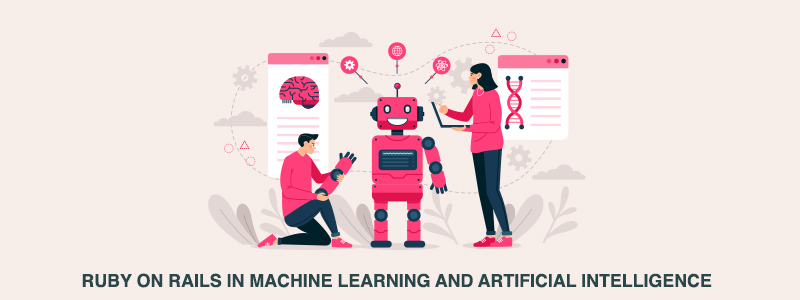Ruby on Rails (RoR), known for its elegant syntax and developer-friendly framework, has found its way into the realm of Machine Learning (ML) and Artificial Intelligence (AI). While Python has been a dominant player in these fields, RoR brings its own set of advantages and can be a powerful choice for building applications that leverage ML and AI. In this blog, we’ll explore the synergy between Ruby on Rails and ML/AI, discussing use cases, benefits, and how these technologies complement each other.
Qu’est-ce que Ruby on Rails ?
Ruby on Rails, which is often simply referred to as Rails, is a web application framework written in the Ruby programming language. Developed by David Heinemeier Hansson, Rails follows the principles of convention over configuration (CoC) and don’t repeat yourself (DRY), emphasizing simplicity and developer productivity. Released in 2005, Ruby on Rails has since gained popularity for its elegant syntax, powerful features, and the rapid development of robust web applications.
Key Components and Concepts:
- Ruby Language:
Ruby is a dynamic, object-oriented programming language known for its readability and simplicity. Rails, being built in Ruby, inherits these characteristics.
- Convention over Configuration (CoC):
RoR minimizes the need for explicit configurations by providing sensible defaults. Developers only need to specify unconventional aspects, reducing the amount of boilerplate code.
- Don’t Repeat Yourself (DRY):
DRY encourages code reusability and modularization. In RoR, developers aim to write code once and reuse it, avoiding redundancy and promoting maintainability.
- MVC Architecture:
RoR follows the MVC architectural pattern, separating the application into three components—Models (data and business logic), Views (presentation layer), and Controllers (application logic and user input handling).
- Active Record:
Rails includes an object-relational mapping (ORM) system called Active Record, simplifying database interactions by representing database tables as Ruby objects.
- Scaffolding:
RoR’s scaffolding feature generates a basic structure for models, views, and controllers, facilitating rapid prototyping and the creation of functional applications with minimal effort.
- Gems:
RoR uses a package management system called Gems, allowing developers to easily add and manage third-party libraries or extend functionality. Gems enhance the extensibility of Rails applications.
What are the advantages of Ruby on Rails?
Advantages of Ruby on Rails:
Developer Productivity:
RoR’s emphasis on conventions and simplicity enhances developer productivity, enabling faster development cycles and easier collaboration.
Readability and Expressiveness:
Ruby’s clean and readable syntax contributes to the expressiveness of RoR code, making it more intuitive and enjoyable to work with.
Community and Ecosystem:
RoR benefits from a vibrant and supportive community, offering a wealth of resources, tutorials, and plugins. The ecosystem is enriched by the availability of numerous Gems for diverse functionalities.
Rapid Prototyping:
With features like scaffolding and convention-driven development, RoR is well-suited for rapid prototyping, allowing developers to quickly turn ideas into functional applications.
Scalability:
While RoR may face scalability challenges for extremely large and complex applications, it can be scaled effectively for a wide range of projects. It remains a reliable choice for startups and mid-sized applications.
What is Machine Learning?
Machine Learning (ML) is a subset of artificial intelligence (AI) that empowers computers to learn and make decisions or predictions without being explicitly programmed for the task. At its core, machine learning involves the development of algorithms that enable machines to identify patterns, learn from data, and improve their performance over time.
Key Concepts in Machine Learning:
Training Data:
Learning from Examples: ML algorithms require vast amounts of data to learn and generalize patterns. This dataset, known as training data, serves as examples for the algorithm to recognize and understand patterns.
Features and Labels:
Input-Output Mapping: In supervised learning, the algorithm learns to map input features to corresponding labels or outcomes. Features are the characteristics or variables, while labels represent the desired output.
Types of Learning:
- Supervised Learning: The algorithm is trained on labeled data, making predictions or classifications based on input-output pairs.
- Unsupervised Learning: The algorithm learns patterns from unlabeled data, identifying inherent structures or relationships.
- Reinforcement Learning: The algorithm learns by interacting with an environment, receiving feedback in the form of rewards or penalties.
Models and Algorithms:
Mathematical Representations: ML models are mathematical representations of patterns in the training data. Algorithms, such as decision trees, neural networks, and support vector machines, implement these models.
Training and Inference:
- Training Phase: During training, the algorithm adjusts its parameters to minimize the difference between predicted and actual outcomes on the training data.
- Inference Phase: In the inference or prediction phase, the trained model is applied to new, unseen data to make predictions or decisions.
Common Machine Learning Applications:
Image and Speech Recognition:
ML algorithms power facial recognition systems, image classification, and speech-to-text applications.
Natural Language Processing (NLP):
ML is used in language-related tasks, such as sentiment analysis, language translation, and chatbots.
Predictive Analytics:
ML models predict future trends, outcomes, or values based on historical data. Applications include stock price prediction, weather forecasting, and demand planning.
Recommendation Systems:
ML algorithms analyze user preferences and behavior to recommend products, movies, or content.
Fraud Detection:
ML models identify anomalies and patterns in financial transactions to detect fraudulent activities.
Healthcare Diagnostics:
ML is applied to analyze medical images, predict disease risks, and assist in diagnostics.
Autonomous Vehicles:
ML algorithms enable self-driving cars to interpret sensory input, make decisions, and navigate safely.
What is the combination of Ruby on Rails and Machine Learning?
The Combination of Ruby on Rails and Machine Learning:
- Ruby on Rails for Web Application Development:
Ruby on Rails excels in developing web applications with its convention over configuration (CoC) and don’t repeat yourself (DRY) principles. The simplicity and speed of RoR make it an ideal framework for building the frontend and backend of applications that incorporate ML and AI components.
- Integration of ML/AI Libraries:
RoR allows seamless integration with ML and AI libraries, even though Python has traditionally been the go-to language for these domains. With gems (Ruby libraries) like ‘ai4r’ and ‘sciruby’, developers can easily bring ML capabilities into their RoR applications.
- Use Cases of Ruby on Rails in ML/AI:
- Predictive Analytics: RoR can be employed to build web interfaces for applications that utilize predictive analytics. Developers can create interactive dashboards and visualizations to showcase ML model results.
- Benefits of Using Ruby on Rails in ML/AI:
- Rapid Development: RoR’s focus on convention and simplicity accelerates development cycles, allowing teams to quickly prototype and deploy ML/AI-powered applications.
- Developer Productivity: RoR’s developer-friendly syntax and extensive documentation make it easy for developers to work on ML/AI projects, even if they are not specialists in these fields.
- Scalability: While RoR might not be the first choice for resource-intensive ML/AI computations, it can handle the orchestration and deployment of ML models efficiently, particularly in scenarios where real-time processing is not critical.
- Challenges and Considerations:
- Limited ML Libraries: While Python boasts a rich ecosystem of ML libraries, Ruby’s collection is comparatively smaller. Developers may need to rely on Python for the core ML functionality while using RoR for web application development.
- Performance Concerns: For resource-intensive ML tasks, RoR might not offer the performance benefits of languages like Python or C++. Considerations about task distribution and parallel processing are crucial.
Conclusion:
Ruby on Rails may not be the first language that comes to mind for Machine Learning et Artificial Intelligence, but its simplicity, convention-driven development, and suitability for web applications make it a viable option. RoR shines when it comes to building user interfaces, managing databases, and orchestrating the integration of ML/AI components. To know more connect with RailsCarma.
Frequently Asked Questions
Yes, Ruby on Rails can be utilized for building applications that incorporate Machine Learning and Artificial Intelligence components. While Python is more commonly associated with these domains, Ruby on Rails can handle the web application development aspects and seamlessly integrate with ML/AI libraries.
The advantages include rapid development due to RoR's convention-driven approach, a developer-friendly syntax that enhances productivity, and the ability to integrate seamlessly with ML libraries. Additionally, RoR's readability and expressiveness contribute to building maintainable code.
One limitation is the smaller ecosystem of ML libraries compared to languages like Python. For resource-intensive ML tasks, RoR may not provide the performance benefits of languages like Python or C++. Considerations about task distribution and parallel processing become crucial.
Ruby on Rails can facilitate the development of web interfaces for applications that leverage predictive analytics or recommendation engines. Developers can use RoR to create interactive dashboards and visualizations, presenting the results of ML models to users.
Ruby on Rails can be employed for managing the deployment and orchestration of Machine Learning models in production. While the core ML functionalities might be implemented using other languages, RoR can handle tasks related to the integration of models into web applications and managing their lifecycle.





